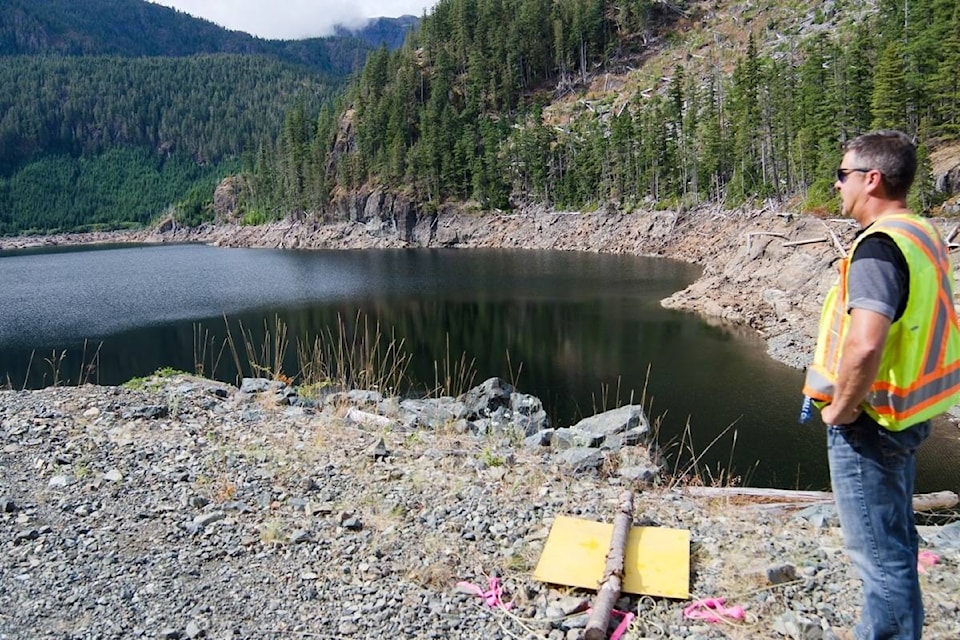This is the first in a three-part, weekly series on the Englishman River watershed and the City of Parksville’s efforts to upgrade its water supply capacity for the coming years.
The steady growth of the City of Parksville has combined with the threat of global climate change and a seemingly annual series of water-use restrictions to create a perfect storm of worry over the ability of the Englishman River to continue to supply the city’s needs in the coming years.
But while the long-term future of the river system may warrant more study, the situation should actually get a lot better over the next two decades, according to Mike Squire, the manager of the $34.5 million Englishman River Water Service project that broke ground earlier this year. The ERWS is a joint venture between the City of Parksville (74 per cent share) and the Regional District of Nanaimo (26 per cent).
“The OCP (Official Community Plan) has envisioned the population (of Parksville) doubling to 25,000 people by 2030,” said Squire. “With this project we’ve exceeded that. We have full capacity up to 2038 or 2040, depending on growth.”
Related: Work begins on Parksville water plant
The new intake system, water treatment plant and distribution mains are scheduled to be commissioned and go online in 2019. But the real key to delivering sufficient water to meet the needs of both Parksville and Nanoose Bay is one of the region’s best-kept secrets: the nearly 20-year-old Englishman River reservoir.
Tucked in the middle of upland forest on the shoulder of Mount Arrowsmith, the reservoir was created by the construction of a $5.5-million dam in 1998-99 that more than doubled an existing lake’s capacity to nine million cubic metres of capacity. It was intended to supplement the use of groundwater wells, which provide about 85 per cent of all drinking water in the service area, according to the city.
The dam and reservoir, which are owned by ERWS, are located in a watershed owned by timber companies Island Timberlands and Timber West. The land for the reservoir’s inundation area and infrastructure was purchased for approximately $800,000, said Squire.
During a tour Squire led this September, near the end of the dry summer season, the reservoir was shown to contain well over half of that capacity, allowing the city to release sufficient volume to meet Fisheries and Oceans Canada requirements for salmon migration and enough to supply the city’s needs, within the restrictions of the current uptake system.
“The tributaries are absolutely dry,” Squire said, pointing out shallow pools of standing water in Centre Creek and a trickle in the South Englishman River during the drive up to the reservoir. “The dam is doing the lion’s share. The dam is doing its job.”
What’s not doing its job is the city’s 40-year-old distribution and treatment system, said Squire, which reached the end of its lifespan two years ago. In November, 2015, Parksville voters in a referendum approved the borrowing of $5.6 million to be pooled with federal and provincial money available for the new water system.
In a related referendum, Nanoose Bay residents overwhelmingly approved the borrowing of $2.6 million for upgrades in the community’s water infrastructure, independent of the Englishman River project.
Not everybody is convinced new infrastructure will supply the city’s needs if it continues to grow. Besides concerns over loss of green space, the most common question brought forward during public hearings for development projects in the city is how water will be supplied to more residents and businesses.
One group of residents supporting the creation of an additional upland water storage system “in case of an emergency” appeared as a delegation before the Regional District of Nanaimo board of directors earlier this year.
Related: Group seeks water storage system
Concerned that a severe drought year could drain reserves in the current reservoir, they argued one or more additional reservoirs could be created to store winter overflow, and be drawn upon through gravity-fed pipes to supply the city in the summer.
Squire pointed out the direct pipeline to the city has been proposed before, but is not practical because the city’s water licence requires a partnership with DFO to provide sufficient water flows for salmon trying to enter the Englishman River system.
The reason for the river’s low water level in summer, he said, is not a lack of water but rather a minimum requirement from the province to provide a flow between 1.4 and 1.6 cubic metres a second for fish habitat — combined with prudent management.
“We’ve had fisheries call and say, ‘Can you release more water?’” Squire said. “We say, ‘Sure,’ because they’ve got pinks staging in the estuary and waiting to go up. But if we’re releasing (water) in June, it makes no sense; it’s above what’s needed for fisheries. We just have to be very careful going into a drought year, when you don’t know what the precipitation’s going to be.”
Although Parksville went more than two months without rain this summer, and Level 3 water restrictions were imposed on the system’s users, this was merely an “average” summer with respect to available water reserves behind the dam, Squire said.
“In 2009, we had a winter with no snow, and we started the spring with the reservoir two feet below the top of the dam,” he said. “That is actually a lot worse than having a dry summer. You really have to manage the release to make sure you have water in September.”
When the new water intake, treatment and distribution system is up and running, he said, Parksville’s high-level water restrictions should be a thing of the past.
“The dam it built to provide a one-in-20-year drought return,” he said. “If the fish are going to take a hit and we have to reduce the flow, then we’re going to take a hit. But in an average year, we’re probably going to stay on (Level) 2.”
